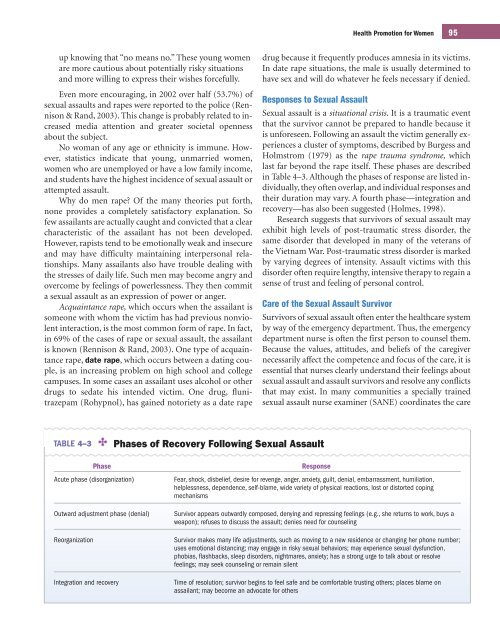Health Promotion for Women - Prentice Hall
Health Promotion for Women - Prentice Hall
Health Promotion for Women - Prentice Hall
You also want an ePaper? Increase the reach of your titles
YUMPU automatically turns print PDFs into web optimized ePapers that Google loves.
lon23944_ch04.qxd 2/10/06 6:46 PM Page 95<br />
up knowing that “no means no.” These young women<br />
are more cautious about potentially risky situations<br />
and more willing to express their wishes <strong>for</strong>cefully.<br />
Even more encouraging, in 2002 over half (53.7%) of<br />
sexual assaults and rapes were reported to the police (Rennison<br />
& Rand, 2003). This change is probably related to increased<br />
media attention and greater societal openness<br />
about the subject.<br />
No woman of any age or ethnicity is immune. However,<br />
statistics indicate that young, unmarried women,<br />
women who are unemployed or have a low family income,<br />
and students have the highest incidence of sexual assault or<br />
attempted assault.<br />
Why do men rape? Of the many theories put <strong>for</strong>th,<br />
none provides a completely satisfactory explanation. So<br />
few assailants are actually caught and convicted that a clear<br />
characteristic of the assailant has not been developed.<br />
However, rapists tend to be emotionally weak and insecure<br />
and may have difficulty maintaining interpersonal relationships.<br />
Many assailants also have trouble dealing with<br />
the stresses of daily life. Such men may become angry and<br />
overcome by feelings of powerlessness. They then commit<br />
a sexual assault as an expression of power or anger.<br />
Acquaintance rape, which occurs when the assailant is<br />
someone with whom the victim has had previous nonviolent<br />
interaction, is the most common <strong>for</strong>m of rape. In fact,<br />
in 69% of the cases of rape or sexual assault, the assailant<br />
is known (Rennison & Rand, 2003). One type of acquaintance<br />
rape, date rape, which occurs between a dating couple,<br />
is an increasing problem on high school and college<br />
campuses. In some cases an assailant uses alcohol or other<br />
drugs to sedate his intended victim. One drug, flunitrazepam<br />
(Rohypnol), has gained notoriety as a date rape<br />
TABLE 4–3 Phases of Recovery Following Sexual Assault<br />
Phase Response<br />
<strong>Health</strong> <strong>Promotion</strong> <strong>for</strong> <strong>Women</strong> 95<br />
drug because it frequently produces amnesia in its victims.<br />
In date rape situations, the male is usually determined to<br />
have sex and will do whatever he feels necessary if denied.<br />
Responses to Sexual Assault<br />
Sexual assault is a situational crisis. It is a traumatic event<br />
that the survivor cannot be prepared to handle because it<br />
is un<strong>for</strong>eseen. Following an assault the victim generally experiences<br />
a cluster of symptoms, described by Burgess and<br />
Holmstrom (1979) as the rape trauma syndrome, which<br />
last far beyond the rape itself. These phases are described<br />
in Table 4–3. Although the phases of response are listed individually,<br />
they often overlap, and individual responses and<br />
their duration may vary. A fourth phase—integration and<br />
recovery—has also been suggested (Holmes, 1998).<br />
Research suggests that survivors of sexual assault may<br />
exhibit high levels of post-traumatic stress disorder, the<br />
same disorder that developed in many of the veterans of<br />
the Vietnam War. Post-traumatic stress disorder is marked<br />
by varying degrees of intensity. Assault victims with this<br />
disorder often require lengthy, intensive therapy to regain a<br />
sense of trust and feeling of personal control.<br />
Care of the Sexual Assault Survivor<br />
Survivors of sexual assault often enter the healthcare system<br />
by way of the emergency department. Thus, the emergency<br />
department nurse is often the first person to counsel them.<br />
Because the values, attitudes, and beliefs of the caregiver<br />
necessarily affect the competence and focus of the care, it is<br />
essential that nurses clearly understand their feelings about<br />
sexual assault and assault survivors and resolve any conflicts<br />
that may exist. In many communities a specially trained<br />
sexual assault nurse examiner (SANE) coordinates the care<br />
Acute phase (disorganization) Fear, shock, disbelief, desire <strong>for</strong> revenge, anger, anxiety, guilt, denial, embarrassment, humiliation,<br />
helplessness, dependence, self-blame, wide variety of physical reactions, lost or distorted coping<br />
mechanisms<br />
Outward adjustment phase (denial) Survivor appears outwardly composed, denying and repressing feelings (e.g., she returns to work, buys a<br />
weapon); refuses to discuss the assault; denies need <strong>for</strong> counseling<br />
Reorganization Survivor makes many life adjustments, such as moving to a new residence or changing her phone number;<br />
uses emotional distancing; may engage in risky sexual behaviors; may experience sexual dysfunction,<br />
phobias, flashbacks, sleep disorders, nightmares, anxiety; has a strong urge to talk about or resolve<br />
feelings; may seek counseling or remain silent<br />
Integration and recovery Time of resolution; survivor begins to feel safe and be com<strong>for</strong>table trusting others; places blame on<br />
assailant; may become an advocate <strong>for</strong> others

















